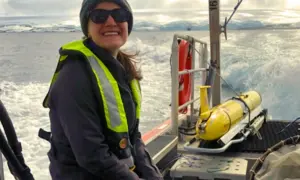The Biden administration is betting that green energy produced by new offshore wind farms will help slow climate change, but fishers and some scientists say there are too many uncertainties about how the massive structures will affect the ocean and its marine life. The first big test of how the push for wind energy might clash with ocean conservation will likely play out in Massachusetts waters. This week, Department of the Interior officials gave initial approval to the $2.8 billion Vineyard Wind project located about 15 miles south of the island of Martha’s Vineyard.
Once the massive wind turbines begin operating in 2023, the wind farm is expected to generate 800 megawatts of clean electricity. That’s enough to power 400,000 Massachusetts homes and businesses.
Vineyard Wind will be the first big offshore wind farm on the East Coast, although smaller pilot projects are running off Block Island, Rhode Island, and Virginia Beach, Virginia. Officials at the Bureau of Ocean Energy Management, an office within the Department of the Interior, are reviewing another 12 commercial offshore wind projects between Maryland and Maine. If approved, those wind farms would generate 25 gigawatts of clean energy for the power-hungry Northeast, more than doubling all land-based wind power coming online in 2021.
It hasn’t all been smooth sailing for wind farms. When WIRED last covered this project, in 2019, it was expected to be completed by 2021. But the Bureau of Ocean Energy Management delayed the project’s approval to review the cumulative impact of US offshore wind farms, while the company itself pulled its application to choose a different kind of turbine. Once that application was resubmitted earlier this year, the bureau approved the final environmental impact statement in several weeks.
The renewed push for offshore wind power is part of a Biden administration executive order issued in January to halt new oil and gas leases on federal lands and offshore waters and replace them with clean energy. Nearly one quarter of all US greenhouse gas emissions come from oil and gas wells on federal leases, and the White House sees a big potential to cut those planet-warming emissions with offshore wind projects.
But the project has gotten pushback from both environmental groups and local fishers, who say they won’t be able to navigate their boats around the 700-foot tall towers or dredge the seafloor for valuable scallops and surf clams without getting tangled in power cables. The cables are “an obstruction and a safety hazard, and they will block fishing access,” says Annie Hawkins, director of the Responsible Offshore Development Alliance, an advocacy group representing the Northeast and New England commercial fishing industry. “The cables take up more space than the turbines and create more risks than the turbines themselves.”
Hawkins says her group has been pushing federal regulators to force Vineyard Wind to make wider sea lanes through the wind farm, so fishing boats would have more room to operate. The current plan has the turbines spaced a mile apart. As part of the overall Department of the Interior environmental review of Vineyard Wind’s application, the US Coast Guard did not approve the idea of broader 4-mile lanes over concerns it could lead to crowding on the seas.
During the decade the project has been under development, Vineyard Wind has shrunk its proposed footprint. Initially, the firm planned to use 100 turbines producing 8 megawatts each. But the technology has improved and turbines have grown bigger and more powerful. Earlier this year, Vineyard Wind switched to GE’s new Halaide-X 13-megawatt turbine, reducing the overall number called for in its plan to 62 turbines, according to company spokesman Andrew Doba.
While the engineering problems of such a large project may seem daunting, trying to figure out what will happen to the surrounding ocean and its denizens is a bit murkier. The Northeast waters are fed by the powerful Gulf Stream current, which brings warm water and tropical species from the south, as well as swirling eddies and a bottom layer of colder water that protects many commercially valuable seafood species. While scientists can use computer models to predict how wind farms might interact with currents, tides, and other ocean circulation patterns, it’s much tougher to come up with real-world examples.
The UK, Netherlands, Germany, and several Scandinavian countries have been building offshore platforms for the past 20 years, but the ocean circulation patterns in the North Sea, English Channel, and Baltic Sea are more influenced by up-and-down tidal currents than the Northeast US. On the other hand, the Northeast is more affected by the Gulf Stream current and big storms like hurricanes and nor’easters that churn up the water below.
Travis Miles, assistant professor of coastal and marine sciences at Rutgers University, says more ocean-based observations are needed to figure out how a wind farm might change circulation patterns—and those effects might vary along the Eastern seaboard. “The potential impacts might be different from New Jersey to Massachusetts,” he says.
Miles and colleagues at Rutgers recently reviewed existing scientific literature on the biological and physical changes that might occur with offshore wind development to a undersea phenomena called the “cold pool,” a blob of cool water that sits on the ocean floor during the summer months and acts as a refuge for scallops, clams, and bottom-dwelling fish like flounder, monkfish, and sea bass. These organisms rely on the cold pool to protect themselves from the warm surface waters heated by the summer sun. There is some speculation that the currents flowing around wind farms could turn into a giant eggbeater, mixing warm surface water into the cold pool, but that hasn’t been shown in any direct field observations, Miles says.
“If you put structures out there, there is potential for mixing,” Miles says. “One of our research questions is, does an array of structures have the potential to increase ocean mixing? We don’t know the answer to that.”
Another unknown is whether turbine blades will slow down the winds that blow across the ocean’s surface, which also drive the movement of currents, or whether the construction noise and electromagnetic fields from transmission cables will affect marine species, including the endangered North Atlantic right whale.
Still, one expert says those problems would likely only affect a small area close to the turbines themselves. “The data and observations from European wind farms suggest that the effects of the installations on current flow and hydrography are localized,” Eileen Hofmann, professor of physical oceanography at Old Dominion University, wrote in an email. “There may be some change in the near vicinity of a turbine installation but there is not evidence that these effects extend very far beyond the installation.”
In 2019, Vineyard Wind and a coalition of environmental groups signed an agreement to limit construction noise and boat traffic when right whales are usually active in the area, between January and April, as well as monitoring underwater sound levels that could interfere with the whale’s communication.
Scientists like Miles and Hofmann say scientific monitoring programs need to be built into the offshore wind farms to make sure they aren’t causing more harm than good. That won’t be easy, Hofman notes, because climate change is also starting to create problems for fish, shellfish, and marine mammals as both water temperature and pH are changing. Many species that are dependent on colder water for food and reproduction are moving north, forcing their predators, like whales, to follow, where they face dangers in busy shipping lanes.
“Attributing changes in fisheries to wind farms will be a challenge for monitoring program design, because productivity is already variable from year to year and climate change will likely be causing impacts at the same time,” Hofmann says. “The effect of the climate is the big unknown.”
As principal scientist at the UK’s Center for Environment Fisheries and Aquaculture Science, Andrew McGill has been tracking how wind farms affect European marine ecosystems. He says the costs and benefits of green offshore energy need to be put in context. “We need to address climate change, and offshore wind farms are better than coal,” McGill wrote in an email. “However there are consequences that need to be anticipated and properly addressed or mitigated. Ignoring them only leads to delay and further issues.”
Photo credit – Eric Thayer/Bloomberg/Getty Images
Full article at Wired (requires email subscription)




